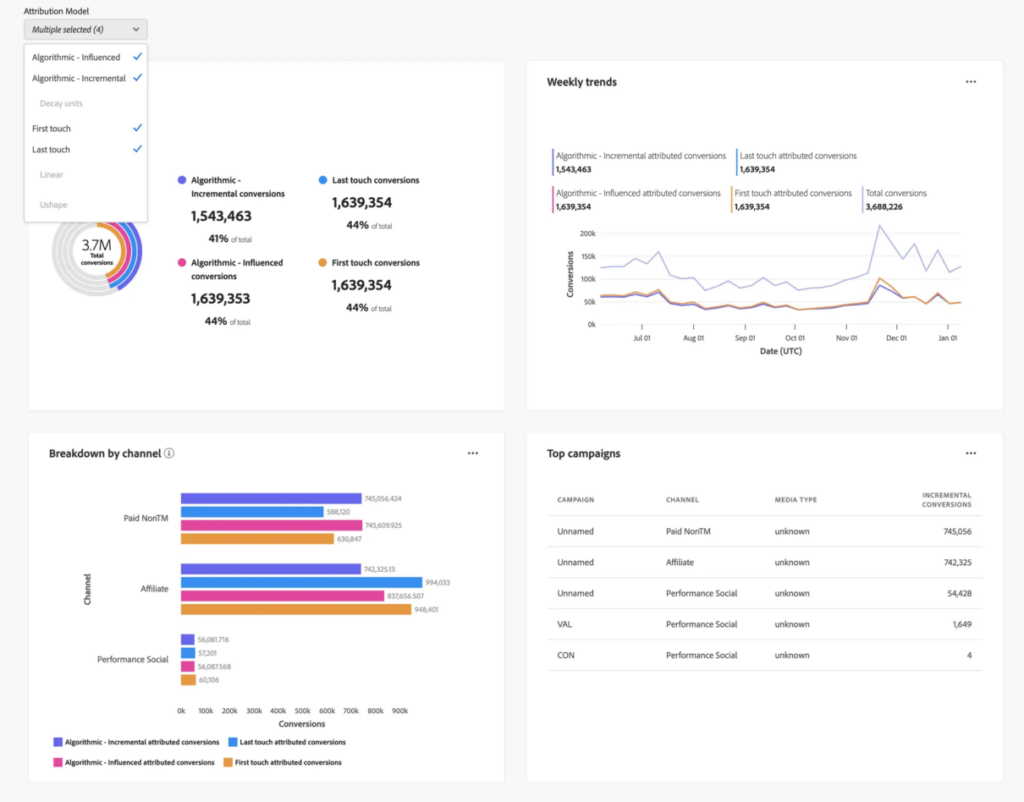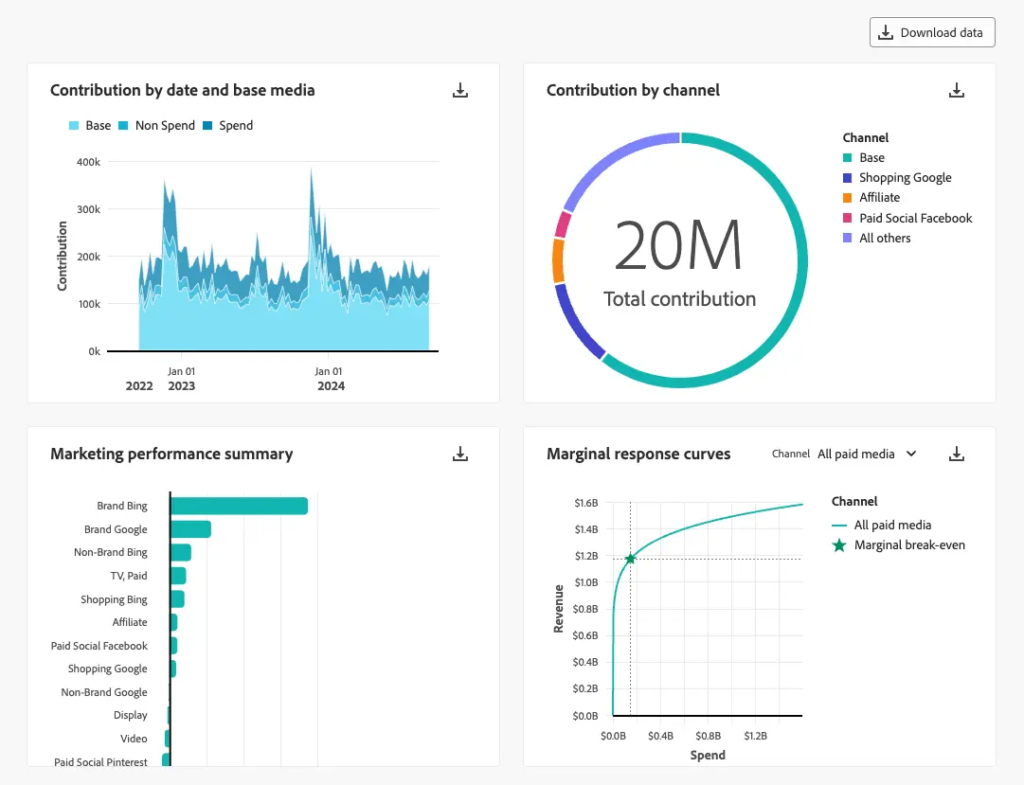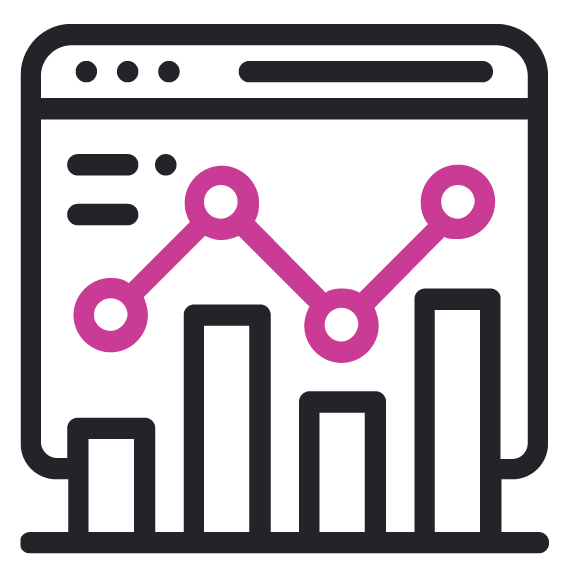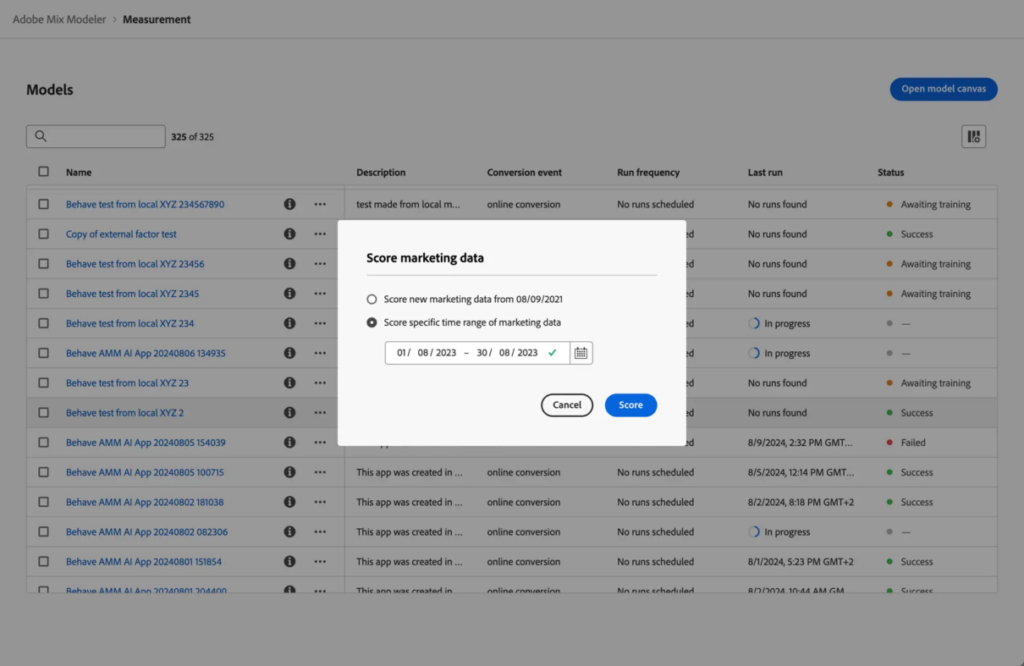Adobe Experience Platform (AEP) offers a one-stop shop for high-quality customer experiences, and AEP’s Adobe Mix Modeler has your marketing data insights covered.
Adobe Mix Modeler merges marketing mix modeling with multi-touch attribution to provide comprehensive, incremental measurements on a unified, customizable platform. The tool’s AI-as-a-service approach helps marketers understand and predict the incremental value of their marketing investments alongside the impacts of key internal and external factors without the time delays of traditional modeling. This gives them the time they need to make an impact and helps them make smarter investments in the future.
BlastX Consulting has partnered with Adobe to present a five-part LinkedIn Live CX Shop Talk series exploring customer experience optimization. We finished strong on September 24, 2024, with session five: Optimizing Marketing Planning and Measurement with Adobe Mix Modeler. View the webinar on demand to learn how Adobe Mix Modeler provides unbeatable insights into the ROI of campaign adjustments so marketers can make the most of their budgets.
Here’s what you’ll learn:
- What is Adobe Mix Modeler?
- Key Features and Capabilities of Adobe Mix Modeler
- What Sets Adobe Mix Modeler Apart?
- Adobe Mix Modeler in the Real World
- Looking Ahead: Adobe Mix Modeler and AEP
Meet Your Adobe Expert

Marisa McKay Tarantino is a Senior Product Marketing Manager at Adobe. She joined the inaugural Adobe Mix Modeler team in February 2024, just four months after Adobe officially released the product. She will be walking you through a deep-dive of Adobe Mix Modeler.
What is Adobe Mix Modeler?

Adobe Mix Modeler uses predictive AI to integrate two of the most common methodologies for planning and measuring marketing effectiveness: multitouch attribution (MTA) and marketing mix modeling (MMM). Each approach has its pros and cons; Adobe Mix Modeler brings users the best of both worlds.

Multi-touch Attribution vs. Marketing Mix Modeling
Take the MTA approach, for instance: While MTA provides fast, granular insights, its data is typically limited to digital marketing channels, excluding analysis of offline channels like TV and radio. On the other hand, MMM incorporates offline channel data to offer a more holistic overview of performance, but conducting an MMM analysis can be tedious and complex, for which reason brands often outsource the process and expect a long wait time for results—several weeks or more.
Plus, Marisa says, the MTA and MMM approaches work better together: “If I have my MTA and my MMM separately, and I get conflicting outputs and results, how do I build organizational confidence in the data that I’ve spent so much time and energy on? That was essentially the genesis of Adobe Mix Modeler.”


AI-Powered Marketing Effectiveness Analysis
Given the right data, Adobe Mix Modeler leverages proprietary machine learning tech to produce robust, 360-degree impact analyses of campaigns and all touchpoints—quickly, and typically with less outsourcing than what’s required with other tools. In one collective, cohesive system, users can measure and understand marketing effectiveness performance across various channels. This empowers marketers to optimize their budgets and drive more effective campaigns in the future.
Marisa recalled that when she first learned about Adobe Mix Modeler, it struck her as innovative and full of potential.
“I’d say that this is probably the most disruptive measurement product that I’ve seen on the market,” she said. “The more I learned about it, the more I was like, ‘Wait, all of the things we’re discussing about this product feel like just the tip of the iceberg.’ There are so many incredibly unique possibilities below the surface, and I felt like I wanted to be part of that innovation.”

The Ideal User
Adobe Mix Modeler targets data-savvy, goal-oriented marketers and their data scientists who are looking for a self-serve data analysis solution to beef up their marketing measurement and scenario planning strategies. The tool can work for just about any vertical, but it best serves traditional direct-to-consumer use cases at organizations with larger marketing budgets.
“The live customers we’ve onboarded and the successful proof of concepts we’ve run to date are across verticals in North America and EMEA.” Marisa said. “We’re hearing the same thing—this tool works much faster than the incumbent solutions, and people report immense time efficiencies.”

Benefits of Using Adobe Mix Modeler
- Breaks down data silos. Adobe Mix Modeler integrates MMM and MTA approaches to provide more well-rounded measurement reporting.
- Gives a 360-degree overview. Adobe Mix Modeler paints a detailed, comprehensive picture of marketing campaign performance across a brand’s full share of wallet, so users better understand which areas drive success and which could use improvement.
- Equips marketers to plan. Users can leverage Adobe Mix Modeler to build scenario plans on top of their models, allowing them to forecast marketing ROI to best optimize their budgets and invest where it counts in the future.
Key Features and Capabilities of Adobe Mix Modeler

Adobe Mix Modeler offers a unified platform for ingesting and harmonizing data, building models, and creating plans. So in addition to the standard event-level data, users can feed aggregate first-, second-, and third-party data into Adobe Mix Modeler, along with other aggregate or summary data.
Here are just a few examples:
- Priors: Incorporates prior model outputs to help train Adobe Mix Modeler on brand-specific learnings achieved in a brand’s previous modeling
- External Data like the S&P500, Consumer Price Index (CPI), and unemployment rates
- Internal Data like seasonal promotions

Understanding Incremental Performance
Isolated data sources, walled gardens, and signal loss make it difficult to measure incremental marketing performance, or additional lift generated by a specific marketing campaign that wouldn’t have occurred without it. Incrementality is challenging to assess when marketing occurs across various channels, especially when disjointed MMM and MTA methodologies produce inconsistent analyses. This poses a challenge to marketers stuck with antiquated tools and data silos: Which marketing strategies and channels are truly driving success?
Adobe Mix Modeler steps in to overcome this hurdle, unifying MMM and MTA methodologies, and offering incremental ROI or CPA (cost per acquisition) for deeper insights.
Adobe Mix Modeler helps marketers understand how all channels are working together so they can invest in the most worthwhile opportunities.
“You can build a model off of orders or another volume-based metric like that, or off of revenue, and then it will always help you understand incrementality,” Marisa told us. “It will group the channels that you define as spend or non-spend, so you can understand how all efforts are driving success on top of your baseline activity.”
Users walk away with a clear understanding of which touchpoints see the most success with incremental conversions. This helps marketers understand how all channels are working together and adjust their budgets to invest in the most worthwhile opportunities.


Harmonizing Data
Adobe Mix Modeler works with event data, which often comes from first-party data sources, and aggregate or summary data, which might come from walled gardens or offline campaigns. The nature of marketing data varies depending on its source, and many tools aren’t able to integrate different types of data to create a holistic overview. But Adobe Mix Modeler breaks the mold with its harmonization service.
“The customer using this tool has complete flexibility and control in defining what model inputs they care about so that they can slice and dice this data and the models in whatever way they want,” Marisa said. “They can set Adobe Mix Modeler up to be flexible at a data field level, so that they can get the insights they care about—without being charged and without time delays we typically see with other solutions.”
Adobe Mix Modeler allows users to configure their data for different perspectives and comparisons. Depending on how much data they have access to, users can split data between online and offline activity, regionally, by publisher, or by retail media network.

Building Models
In the Adobe Mix Modeler platform, users can configure, train, and score models—then re-train, and re-score—to create the perfect custom fit for their unique business, at no additional charge.
“The model configuration is also incredibly flexible, and we allow users to retrain, rescore and incrementally score models as needed without additional costs.” Marisa explained. “Based on our conversations with customers, that ability is pretty unique.”
Driven by machine learning, Adobe Mix Modeler’s models analyze marketers’ investments to measure and predict specific outcomes. Users must input the following into each model:
- One conversion
- Marketing touchpoints comprising summary-level data, marketing touchpoint data, or both
- A configurable lookback window
- A configurable training window
They may also include information on external or internal factors, previous marketing contributions from other sources, or spend shares. From there, users can adjust variables, dimensions, and outcomes to create multiple model variants.
With Adobe Mix Modeler, you can retrain and rescore and get your data the next day—and you’re not paying extra for it.
“A traditional partner, whether that’s an agency or another tech and service provider, is going to charge you for that,” Marisa elaborated. “And they’re going to tell you, ‘Oh, it’s going to be another few weeks before I can get this to you.’ With Adobe Mix Modeler, you can retrain and rescore and get your data the next day—and you’re not paying extra for it.”
She went on to explain that Adobe Mix Modeler displays dynamic marginal response curves for each whole model and the individual channels within each model.
“This shows you at what point you’ll start to see diminishing returns, but it also shows you where the break-even point is,” she said. “At what point will you actually start to see less than a dollar back for every dollar that you spend? You can look at that by date range within a model. You can even look at that by channel within a date range within a model.
“We’ve made it really easy for you to see the actionable learnings from the model’s output, and what actions to take next that will help you run your marketing more efficiently.”


Creating Plans
Adobe Mix Modeler’s planning feature is the cherry on top, providing guidance on the next campaign using the model’s insights. Users can create and compare media plans to understand what to spend by channel within a specific date range and what they can expect as a business outcome, like the ROI or CPA for that next campaign—all using the model’s insights.
Marisa provided some extra insight into how this benefits marketers in the real world: “If it looks like you need to update your spend because you’re starting to oversaturate the paid social channel for a given type of campaign, Adobe Mix Modeler can tell you that. If you’re trying to figure out, ‘Where does it look like I still have room to operate?’ You can easily build a plan and compare it with other options.”
The platform leverages predictive AI to tell users where to spend based on their marketing budget, even within the constraints of contracts with partners or vendors. As Marisa explained, “It brings together different practices organizationally in a way that just makes a lot of sense.”
What Sets Adobe Mix Modeler Apart?

Marisa emphasized that Adobe Mix Modeler is faster and more configurable than other marketing measurement and planning tools, making it stand out against the competition.

Customized to Your Business
Adobe Mix Modeler affords a level of flexibility and autonomy that other tools on the market just can’t touch.
“When you use this tool, you’re able to manipulate and configure it to fit within your niche business objectives,” Marisa explained. “We’re giving you the ability to not only put in your own marketing data, but also any other factors that impact your business.”
Adobe Mix Modeler’s Business Factor Insights feature equips users to plan more confidently with projected impacts in mind.
Take Adobe Mix Modeler’s Business Factor Insights, for instance. This feature measures and predicts the incremental impacts of both external and internal business factors, equipping users to plan more confidently with those projected impacts in mind.
To further illuminate the power of the feature, Marisa described how Adobe Mix Modeler’s enhanced Business Factor Insights might apply to a sports league. Let’s say the league’s marketing team wants to know how weather patterns—an external factor—impact performance. These marketers could use Adobe Mix Modeler to ingest relevant data on temperature, rainfall levels, ticket sales, drink and food sales, and even bobblehead distribution to determine how these factors relate to each other, compared to other external factors like the consumer price index, and ultimately, how that interplay could impact their marketing effectiveness.

Bi-Directional Transfer Learning Capability
Adobe has a patent pending on its unique and exciting new bi-directional transfer learning capability. Where Google’s and Meta’s tools use additive regression models, as do many in-house platforms, Adobe intentionally used a multiplicative linear regression model to build Adobe Mix Modeler.
“We needed something that could score each channel relative to the others to account for the impact channels have on each other.” Marisa recalled when explaining the genesis of Adobe Mix Modeler. “So rather than running each channel’s model in a silo, this assumes we’re running channel A, channel B and channel C models concurrently. This means results are produced faster and can be used to improve forecasting.”
Thanks to that interplay, marketers can rely on Adobe Mix Modeler’s insights for scenario planning and forecasting.

Quicker Insights and Planning
Adobe Mix Modeler gives marketers the insights they need, fast—and empowers them to plan for smarter investments and better campaigns in the future.
“You can have model insights within days, not weeks or months, and the planning on top of it is another differentiator,” she said. “We’re allowing the business stakeholder to do something meaningful with the data their analyst is giving them.”
Adobe Mix Modeler in the Real World

Adobe Mix Modeler is an Adobe solution to an Adobe problem. According to Marisa, the Adobe marketers of 10 years ago were fed up with antiquated measurement tools and delayed, inapplicable insights.
“They were making really strategic, expensive decisions without timely data to back those decisions up,” she explained. So Adobe’s data scientists solved this problem with the first iteration of Adobe Mix Modeler. Originally, the tool’s creators ran their own code and models on an ad-hoc basis to produce the insights they needed.
The internal team at Adobe saw around an 80% return on media investment from Adobe Mix Modeler in the last five years alone. That’s huge.
“Eventually, the digital media team at Adobe started making billion-dollar decisions based on this data, and they were seeing that the data was accurate and that the results were meaningful,” Marisa said. The internal team saw around an 80% return on media investment from Adobe Mix Modeler in the last five years alone. “That’s huge, almost unbelievable—but they have the data to back it up.”
Adobe then decided to launch these models as a productized solution in another Experience Platform application, Adobe Mix Modeler, in October 2023.
Looking Ahead: Adobe Mix Modeler and AEP

Though Adobe Mix Modeler is a versatile tool that’s tough to categorize, it lives under the data and insights umbrella within AEP. Marisa foresees lots of interplay between Adobe Mix Modeler and Customer Journey Analytics (CJA) in the coming year, part of an overarching trend toward operational efficiency.
“How can we continue to make it simple for you to tie in macro insights from Adobe Mix Modeler to dollars and cents for your business?” she asked. “How do you tactically optimize campaigns at a touchpoint level in Adobe CJA, and how can you use incremental modeled data to guide those decisions?”
Get the Most Out of Adobe Mix Modeler
Adobe Mix Modeler provides actionable insights so marketers can make high-value adjustments and plan campaigns with confidence. We shared a first look at the tool in our September 24th LinkedIn Live CX Shop Talk session with Adobe. Missed it? View it on demand today to learn more about Adobe Mix Modeler’s measurement and scenario-planning capabilities—and don’t hesitate to reach out to our team with questions!
Want to dig deeper? Here’s where you can find more details on Adobe Mix Modeler:


